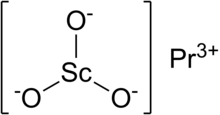
| |
| Names | |
|---|---|
|
IUPAC name
Praseodymium orthoscandate
| |
Other names
| |
| Identifiers | |
3D model (
JSmol)
|
|
| |
| |
| Properties | |
| PrScO3 | |
| Appearance | green solid [1] |
| Density | 5.9 g/cm−3 [2] |
| Melting point | 2200°C [1] |
Except where otherwise noted, data are given for materials in their
standard state (at 25 °C [77 °F], 100 kPa).
| |
Praseodymium orthoscandate is a chemical compound, a rare-earth oxide with a perovskite structure. It has the chemical formula of PrScO3.
Preparation
Praseodymium orthoscandate can be obtained by reacting praseodymium(III,IV) oxide with scandium oxide. [1]
Properties
Praseodymium orthoscandate is a green solid. It has an orthorhombic perovskite-type crystal structure with space group Pnma (space group No. 62). [1]
In 2021, with the help of electron ptychography, researchers were able to achieve the highest magnification. In this way, the researchers managed to enlarge the atoms of a praseodymium orthoscandate crystal by a factor of 100 million. [3] [4]
See also
References
- ^
a
b
c
d Thorsten M. Gesing, Reinhard Uecker, J.-Christian Buhl (2009), "Refinement of the crystal structure of praseodymium orthoscandate, PrScO3", Zeitschrift für Kristallographie - New Crystal Structures (in German), vol. 224, no. 3, pp. 365–366,
doi:
10.1524/ncrs.2009.0159,
ISSN
2197-4578
{{ citation}}: CS1 maint: multiple names: authors list ( link) - ^ SpringerMaterials: PrScO3 (ScPrO3) Crystal Structure - SpringerMaterials, retrieved 17 August 2021.
- ^ Spectrum of Science: Atome in Rekordauflösung - Spektrum der Wissenschaft, retrieved 17 August 2021.
-
^ Zhen Chen, Yi Jiang, Yu-Tsun Shao, Megan E. Holtz, Michal Odstrčil, Manuel Guizar-Sicairos, Isabelle Hanke, Steffen Ganschow, Darrell G. Schlom, David A. Muller (2021),
"Electron ptychography achieves atomic-resolution limits set by lattice vibrations", Science (in German), vol. 372, no. 6544, pp. 826–831,
arXiv:
2101.00465,
Bibcode:
2021Sci...372..826C,
doi:
10.1126/science.abg2533,
ISSN
0036-8075,
PMID
34016774,
S2CID
230435950
{{ citation}}: CS1 maint: multiple names: authors list ( link)

| |
| Names | |
|---|---|
|
IUPAC name
Praseodymium orthoscandate
| |
Other names
| |
| Identifiers | |
3D model (
JSmol)
|
|
| |
| |
| Properties | |
| PrScO3 | |
| Appearance | green solid [1] |
| Density | 5.9 g/cm−3 [2] |
| Melting point | 2200°C [1] |
Except where otherwise noted, data are given for materials in their
standard state (at 25 °C [77 °F], 100 kPa).
| |
Praseodymium orthoscandate is a chemical compound, a rare-earth oxide with a perovskite structure. It has the chemical formula of PrScO3.
Preparation
Praseodymium orthoscandate can be obtained by reacting praseodymium(III,IV) oxide with scandium oxide. [1]
Properties
Praseodymium orthoscandate is a green solid. It has an orthorhombic perovskite-type crystal structure with space group Pnma (space group No. 62). [1]
In 2021, with the help of electron ptychography, researchers were able to achieve the highest magnification. In this way, the researchers managed to enlarge the atoms of a praseodymium orthoscandate crystal by a factor of 100 million. [3] [4]
See also
References
- ^
a
b
c
d Thorsten M. Gesing, Reinhard Uecker, J.-Christian Buhl (2009), "Refinement of the crystal structure of praseodymium orthoscandate, PrScO3", Zeitschrift für Kristallographie - New Crystal Structures (in German), vol. 224, no. 3, pp. 365–366,
doi:
10.1524/ncrs.2009.0159,
ISSN
2197-4578
{{ citation}}: CS1 maint: multiple names: authors list ( link) - ^ SpringerMaterials: PrScO3 (ScPrO3) Crystal Structure - SpringerMaterials, retrieved 17 August 2021.
- ^ Spectrum of Science: Atome in Rekordauflösung - Spektrum der Wissenschaft, retrieved 17 August 2021.
-
^ Zhen Chen, Yi Jiang, Yu-Tsun Shao, Megan E. Holtz, Michal Odstrčil, Manuel Guizar-Sicairos, Isabelle Hanke, Steffen Ganschow, Darrell G. Schlom, David A. Muller (2021),
"Electron ptychography achieves atomic-resolution limits set by lattice vibrations", Science (in German), vol. 372, no. 6544, pp. 826–831,
arXiv:
2101.00465,
Bibcode:
2021Sci...372..826C,
doi:
10.1126/science.abg2533,
ISSN
0036-8075,
PMID
34016774,
S2CID
230435950
{{ citation}}: CS1 maint: multiple names: authors list ( link)